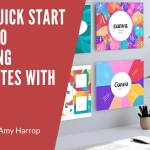 When you sell your self-published books, you’re not just selling books.
When you sell your self-published books, you’re not just selling books.
That might sound confusing, but it shouldn’t be.
You’re selling yourself.
As a self-published author, your name is your brand. You’ve probably had the experience of reading a book and thinking, “I can’t wait to read the other books written by this author!”
Guess what? Your readers have that too.
Even if you’re creating low-content books, if you do a good job people are going to want the other books you’ve written.
Part of marketing your books is marketing yourself. In this post, I’ll explain some things you can do to create a memorable brand for yourself as a self-published author.
What is a Brand?
A personal brand is not just one thing. It’s a collection of impressions and qualities that define who you are and – more importantly – how your audience sees you.
We all like to assign personality traits to brands. All you need to do is check out the social media accounts of some of your favorite brands. What you’ll find is that they’re wildly different from one another.
A good example is Dove, the company that makes soap, moisturizer, and other beauty products. They have a warm, feminine brand that’s dedicated to celebrating women of all ages.
Everything you do professionally, online or offline, defines your brand. Your brand should be reflected in:
- Your author website and its design and content
- Your blog posts
- Your social media accounts (including your profiles, pictures, and bios)
- Your book descriptions and listings on Amazon and other sites
- Your forum posts
- Your books, both printed and electronic
Every word you say online must be related to your brand. If you muddy the water, you’ll confuse your target audience. That means your brand must be consistent with the image you want to project.
Defining Your Brand
Defining your brand is not just about understanding who you are – although of course, you should understand who you are!
It’s about knowing how you want your audience to think of you, and then crafting your brand to elicit the response you want.
That might sound devious, but it’s not. Branding is like fine-tuning who you are. The people who read your books don’t know you as a person. Your job is to make them feel that they know you.
Here are some questions to ask to help you define your personal brand:
- What are my areas of expertise?
- How do I want my readers to feel about me?
- What will make potential readers want to follow me on social media or buy my books?
Once you’ve answered these questions, you can start to build your brand.
It might feel odd to brand yourself, particularly if your brand is your name. I get that, because my brand is my name.
Remember, your brand is a distilled version of you. It should be true to who you are, but it doesn’t need to be ALL you are.
What personality traits would you assign to your brand? If you’re selling planners and organizers, for example, your brand personality traits might be:
- Organized
- Practical
- Knowledgeable
- Straightforward
The personality traits you use for your brand will inform everything you do online, from the design of your website to the tone of your social media posts.
Keep in mind that it’s perfectly fine to include some unexpected traits in your brand. You can be organized and practical while also being irreverent and funny.
The key is to make your brand unique. What sets you apart from the other self-published authors in your niche? Those things are what will differentiate you and make your brand memorable.
How to Use Your Personal Brand Online
Now, let’s talk about some of the ways you can use your personal brand online. Remember, your branding must be consistent and memorable.
Your Website’s Design
Your web design should clearly reflect your personal brand. Let’s use the example above: an author who publishes planners and organizers. Her brand characteristics are organized, practical, straightforward, knowledgeable, irreverent, and funny.
What could you do with web design to illustrate those traits?
The first thing I think of is that if I’m going to trust someone to tell me how to plan and organize my life, I want their website to look clean and modern. It should be easy to navigate and laid out in a way that makes sense.
The straightforward part can be taken care of with matter-of-fact written content that gets right to the point.
By creating content that demonstrates a deep knowledge of how to organize and plan, this author would clearly show that she’s knowledgeable.
The irreverent and funny part is where she could cut loose and have some fun. Content can be straightforward and funny at the same time. Making jokes about organization (or disorganization) can help make her posts entertaining.
Social Media Posts
Personal branding on social media is about your profiles and the things you post.
Our imaginary author should plan on using her author photograph as her profile picture across all social media sites. That will give her the consistency she needs to build a recognizable brand.
She may also want to use her logo, if she has one. She could incorporate some of the design elements of her website in her cover photos on Facebook and Twitter.
Of course, she’ll keep the tone of her posts consistent with her brand. That’s true whether she’s sharing a photo on Instagram or posting a video on YouTube.
Social Mentions
One of the best ways to ensure you’ve got a consistent brand is to track your social mentions. You can do that with Hootsuite and other tools.
Tracking mentions can help you get a feeling for what others say about you online. Even if you have a small following, it can be useful to see if your brand is making an impact.
Remember, consistency is the key with online branding. If you start with the personality traits you want to convey and build your brand from there, you’ll be sure that your website, social media accounts, and mentions are all improving your brand recognition.



